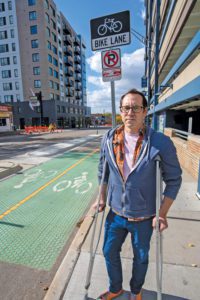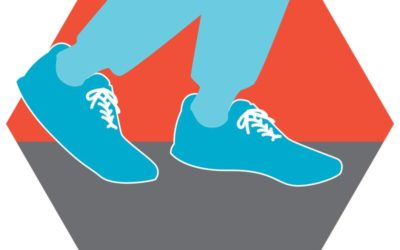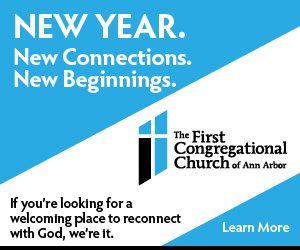Christopher Becker was biking home from his job at the Ann Arbor District Library on August 24, riding in the bike lane down the hill on William St. between First and Ashley. An Amazon delivery van pulled over into the bike lane and parked directly in front of him. Becker swerved to avoid the vehicle, went onto the sidewalk, and hit a wall.

In August, an Amazon truck blocked a bike lane on W. William. Unable to stop in time, bicyclist Christopher Becker flew into a wall. The driver ignored him to make the delivery. In October, Becker was still on crutches and awaiting surgery. | Photo: Mark Bialek
“She made a delivery while I was on the sidewalk waiting for the paramedics to show up and never apologized,” recalls Becker. “She was so unaffected by the whole thing. It was shocking.”
Law enforcement never arrived on the scene, and although Becker filed a police report, he doesn’t know if the driver was cited. He injured his knee in the crash and now has difficulty walking; bicycling is out of the question.
“Share the road” is a familiar slogan, but it seems to be harder in practice than in theory. In Becker’s case, the white stripe marking the bike lane didn’t stop the van from blocking him, raising the question: How protective is a bike lane, really?
The Ann Arbor Police Department reported 245 crashes involving bicycles in the last five years—170 with injuries and one resulting in death. It’s not uncommon for motorists to behave aggressively around cyclists: yelling at them, honking at them, and sometimes worse.
“I’ve been flipped off by trucks that are coming in the other direction,” says Becker. “Just my presence is enough to make some people enraged.”
On a ride with the Ann Arbor Bicycle Touring Society, board member and ride leader Dan Harrison saw a motorist throw a water bottle at a cyclist’s face. She ended up needing eye surgery.
“I like to think that it’s less than one percent [of drivers who are hostile], but you remember that one percent cause they’re so rude,” says Harrison.
—
In 2021, Ann Arbor was named a Gold-Level Bicycle Friendly Community by the League of American Bicyclists—the first and only Gold BFC in Michigan and one of only thirty-five such cities in the U.S. (Although it is worth noting that there are two ranks above Gold: Platinum and Diamond.) Bicycles—and the infrastructure to use them safely—have a central role in two city priorities: eliminating fatalities and injuries due to vehicle accidents by 2025 and achieving carbon neutrality by 2030.
According to a 2019 study in the Journal of Transport & Health, more bike facilities, particularly protected and separated lanes, are associated with lower traffic speeds and better safety for everyone using the road. More bicycles means fewer motor vehicles and lower carbon emissions, and bicycle infrastructure of all kinds provides safe, inexpensive transportation alternatives for low-income populations.
The city is working on what it calls the All Ages and Abilities Network: a 102-mile connected bicycle network, complete with way-finding signage. When it’s complete, 95 percent of Ann Arbor’s population will live within a quarter mile of bicycle infrastructure linking them to work and leisure destinations.
“These are aspirational goals, because these are goals worth aspiring to,” says Suzann Flowers, the city’s transportation program manager. But aspiration is ahead of construction: So far, only twenty-six miles of the network are in place. Twenty-eight miles of existing infrastructure are in need of enhancements, and forty-eight miles remain to be built between now and 2035.
And incidents such as Becker’s raise questions about the practical efficacy of the system. We live in an age of home delivery, but if the shoulder belongs to cyclists, where are delivery drivers supposed to park? What efforts are being made to educate motorists and cyclists, and to enforce the laws that protect vulnerable road users? And how is a fragmented network of bicycle infrastructure going to serve cyclists of all ages and abilities?
—
“If you don’t have enforcement, then people know that and they’re probably more likely to violate the law,” says AAPD sergeant Mark Pulford.
It’s illegal for vehicles to park in a bike lane, but as Becker found, violators usually have time to drive away before enforcement arrives. The AAPD has seventeen fully outfitted police bicycles, but Pulford says limited staff prevents police officers from using them much. Staffing issues also mean officers must prioritize more urgent calls.
The League of Michigan Bicyclists is working to educate Michigan drivers through public service ads, training, and enhanced driver’s education curricula. They’re also lobbying for harsher penalties for drivers who injure or kill a vulnerable road user. Currently, a Michigan driver who kills a bicyclist can get away with a misdemeanor charge carrying penalties of one year in jail and/or a fine of $2,000. Four bills were introduced in 2021 that, if passed, would make it a felony punishable by fifteen years in jail or a $7,500 fine. But the league has no initiatives underway to address the issue of motorists driving and parking in bicycle lanes.
Vehicles aren’t the only obstacles. Refuse bins, litter, and snow are other common obstructions in Ann Arbor’s bike lanes.
The public works department proactively informs the community that refuse bins do not belong in bike lanes, says its manager, Molly Maciejewski, adding that complaints should be reported to the AAPD’s community standards unit. The unit is only available between 7 a.m. and 3:30 p.m. on weekdays, and every option on the automated phone menu brings you to voicemail.
As for snow, city policy is to plow curb-to-curb within twenty-four hours—including bike lanes without physical barriers, such as curbs and bollards—whenever there is at least an inch of snow. But even when that’s done, property owners may plow a driveway or shovel a sidewalk and leave the snow on the shoulder.
The physical barriers on protected bike lanes, like curbs and bollards, mean they must be cleared separately using a smaller plow pushed by a pickup truck or four-wheeler. Walking and biking paths not connected to the road—including parts of the Border-to-Border Trail—are not plowed at all, remaining impassable until the snow melts.
—
I was new to Ann Arbor and exploring the city by bicycle with the help of Google Maps. The app has a bicycle filter that marks bike lanes with a solid green line and bike-friendly roads—think sleepy local streets with twenty-five-miles-per-hour speed limits—with a dashed green line.
I started on Liberty (a dashed green line), and then turned onto the new Division St. bikeway. It was a pleasant ride… until the bike lane completely disappeared, depositing me into the tangled intersection of Division, Detroit/Summit, Carey, High, and Broadway/Beakes. Carey down to Depot was a dashed green line according to Google, but a bone-rattling brick road in real life. I decided to ride the sidewalk instead, and when I had a chance to cross Depot and take the new railroad underpass to the Border-to-Border Trail, I took it gladly.
For an experienced cyclist, situations like this just require a little improvisation—hop on the sidewalk for a block or two, wait for a break in traffic, and dart to the safety of the bike trail. But if the city wants to court cyclists of all abilities, that means actually following through on its promise of connected bike infrastructure.
Ann Arbor has nearly 150 miles of bike lanes, paths, and shared roadways—52.7 miles of which have been added in the last ten years. Recent projects include a redesign of State St. with painted bike lanes that connect the William St. Bikeway to North University, and the addition of a protected bikeway on Catherine St./Miller Ave. Next year will see the addition of buffered bike lanes at the intersection of N. Huron and Seventh, as well as on Glazier Way. Future plans include replacing on-street parking with bike lanes on a section of Barton Dr., on Seventh St./Greenview Dr., and on four blocks of S. Division.
What’s the rationale behind adding just four blocks to a bike lane? Flowers explains that on any reconstruction project—roads, water mains, sewer work—the city looks for opportunities to add biking facilities. Although the result might appear “piecemeal,” she says, it keeps them from “digging up the same road twice” and ultimately brings them closer to the goal of citywide connectivity.
But then there’s the Catherine/Miller bike lane. A reader of the Observer—herself a seasoned bike commuter—emailed about the city’s decision to switch the bike lane between State and Thayer to the south side of the road.
“This means that when biking west on Catherine from the hospital the bike lane is on the north side of the road between Glen and Thayer, then switches to the south side of the road between Thayer and State, then back to the north side after State and through Main Street where it remains on the north side of the road all the way west on Miller,” the cyclist wrote. “My concern is that this bike lane pattern leads to bikers having to diagonally cross two intersections. The most concerning being at State and Catherine as bikers must compete with cars driving westbound who have a green light.”
Amber Miller, Downtown Development Authority capital projects and planning manager, explains that the Miller/Catherine bikeway will ultimately connect First and Division and that there are discussions about possibly extending it east of State and west of First. Situating the bikeway on the north side of Catherine was a pilot program. After weighing public input with detailed design sessions, the design team ultimately decided the south side of the street was the optimal location, as it created a safe transition to the Division Bikeway.
“As these projects can’t all be implemented simultaneously, it results in interim conditions that are not as clear and consistent as the eventual long-term arrangement,” emails Miller.
—
“I see more and more people riding a bike all the time, and I’m grateful to the city and the transportation commission for giving us more bike lanes,” Becker says. Despite his own accident and injury, “I still think the protected bike lanes in downtown are—they’re almost a miracle.”

The city is counting on more bike routes to meet its goal of eliminating vehicle injuries and deaths by 2025, and more riders to meet its carbon-neutrality goal by 2030. It’s built fifty-three miles of bike paths in the last decade—but its “All Ages and Abilities” network won’t be complete until 2035.
However, not everyone shares this sentiment. A reader of the Observer recently emailed describing bike lanes as a “waste of public funds” and inquiring about “the cost-to-date and projected cost of this boondoggle.”
Flowers says that the city’s strategy of adding bicycle infrastructure to other construction projects makes it nearly impossible to put an exact number on the cost of bicycle-specific infrastructure. That said, according to the Ann Arbor Transportation Commission, fiscal year 2023 has an anticipated expenditure allocation of $30
million, less than $1 million of which is earmarked for nonmotorized transportation.
Flowers acknowledges that no infrastructure system is going to please everyone, but says that the city is committed to expanding transportation options.
“There’s just been a paradigm shift, not only nationally, but within our own community, about what travel means,” she says. “And if we’re going to reach some of the sustainability goals that the city has put forth, that the community has supported, we have to look at ensuring that there are other transportation options besides the single-occupancy vehicle.
“That doesn’t mean that there still isn’t space for single-occupancy vehicles, it just may take you slightly longer to get there.”
—
Becker recently—and “reluctantly’’—got a lawyer. He plans to file a lawsuit after undergoing meniscal repair surgery later this month.
“Something real has been taken away from me, and with every passing day, I am increasingly frustrated and upset at how I can’t move my body,” he says. “Asking drivers to not do this is not working, so a lawsuit could get some compensation and to try to nudge society in a certain direction is my only recourse.”
But Amazon does not directly employ the people who make its deliveries or even own the logo-wrapped trucks they drive. Amazon Logistics contracts with smaller companies through its Delivery Service Partner Program. That may protect it from legal action—even though drivers must use the Amazon Flex app, which sets time limits for their deliveries, sends text message alerts when they fall behind, and docks their pay if that happens too frequently.
Even when it’s sued, Amazon appears to be undeterred. Bloomberg reported that between January and November 2021, Amazon Logistics was a defendant in at least 119 motor vehicle injury lawsuits—four times as many as in all of 2020—yet the problem seems to continue unabated.
The Instagram account Bike Lanes of Ann Arbor has no shortage of photos of Amazon vehicles—and FedEx trucks, a school bus, and even an AAPD SUV—blocking bike lanes, but the public shaming doesn’t seem to be helping. And despite the city’s ambitious plans for a cohesive bicycle network, the gaps—both in the infrastructure and in people’s understanding of how to use it—are creating an untenable situation.
The solution might lie in some combination of engineering, improved education, enhanced enforcement, and personal responsibility. Pulford puts it well, speaking slowly and choosing his words carefully.
“Unfortunately, in today’s fast-paced society, it seems like everybody’s in a rush. And if anything comes in their way or slows them down, it seems like that frustration builds rather quickly.
“It’s one thing to teach somebody what the laws are. But is there something to be said about patience and courtesy—trying to better instill that into our culture?”
—
Calls & Letters, December 2022: Buffered, not protected
Our November article “Building a Bike-Safe City” erred in describing the bike lane where Christopher Becker was cut off by an Amazon delivery truck. It is “buffered” by an extra painted line, not “protected” by concrete curbs—making it much easier for the truck to block.





The only solution to vehicles parking on bike lanes:
https://www.redbubble.com/i/sticker/You-park-like-a-real-dick-by-MarcoPolok/49171264.EJUG5
I have no objection to bike lanes and safety. I do object to the city not properly creating more alternatives to cars when it is altering city streets in favor of bike lanes. Ann Arbor has thousands of people commuting into and out of it it each day, and the emphasis on bike lanes makes it more and more difficult as time goes on. Why not have large enough park and rides for commuters on the city periphery? Has anyone tried approaching the owners of the Briarwood Mall, where many spaces go unused, or Meijer on Ann Arbor Saline Road, right next to I-94? Cut down on the vehicular traffic and it will be easier on everyone, bikers and drivers alike. Some of those living outside the city would love that alternative. Be practical.
Has anybody considered doing a traffic study on the new bike infrastructure to determine how many people actually use the bike lanes? Wouldn’t it make sense to do this and then decide if it’s worth the money to build any more bike lanes? That’s how they determine if road widening are needed. Why not use the same technology to determine if bike lanes are necessary?
The city of Ann Arbor is uninterested in how many people actually use bike lanes. They have decided that they must be built, and people should not drive cars. Everyone on the road can see that there are a hundred cars for every bike. It’s a waste of money and a huge inconvenience for everyone but bicycle hobbyists and the tiny fraction of people who “commute” on bikes. It’s nonsense.